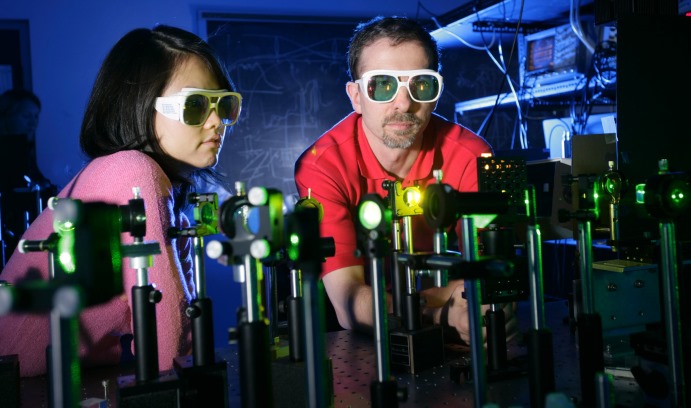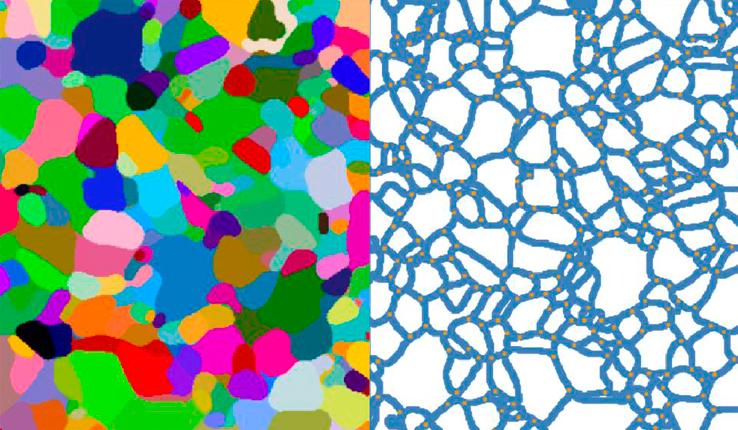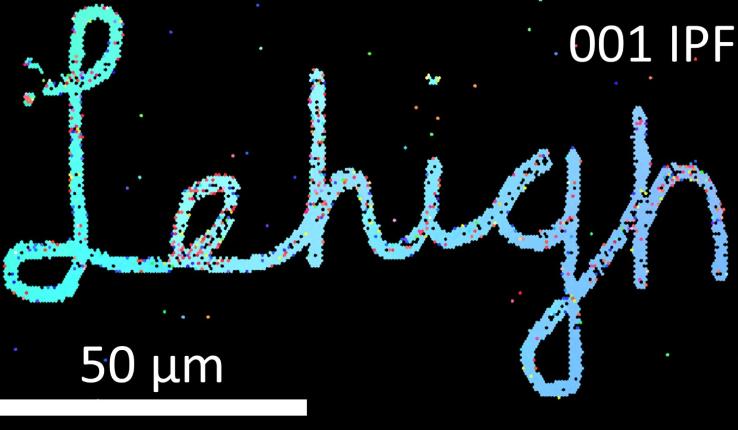Optimizing the Materials that Mediate Light-Light Interactions

Ivan Biaggio (right) and his group have determined the limit to which donor-acceptor molecules can be increased in size before they cease to improve the efficiency of third order nonlinear optics. (Photo courtesy of Lehigh department of physics)
A large number of researchers are working in the area of nonlinear optics, which is the study of all effects that can be described as multi-photon interactions in materials systems, including cases where the frequency of one or more photons tends to zero.
Motivated by the needs of these researchers, meetings have been organized in the past few years under the name “Foundations of Nonlinear Optics.” The two most recent meetings were held at Lehigh in 2015 and Tufts University in 2016, and the next one is scheduled to take place at the University of the Bahamas.
The Journal of the Optical Society of America B recently published a special issue containing contributions from participants at these and other meetings. Titled "Nonlinear optics near the fundamental limit," the issue contains articles ranging from the fundamental, first principles analysis of the nonlinear response and its origins, to experimental work. It is edited by Ivan Biaggio, professor of physics at Lehigh, Timothy J. Atherton of Tufts University, and Koen Clays of KU Leuven, Belgium.
According to the issue’s introduction, the issue “is dedicated to works on both second-order nonlinear optics (three-photon interactions) and third-order nonlinear optics (four-photon interactions) that focus on understanding the fundamental mechanisms of the nonlinear optical response when the nonlinearity is large and approaches the fundamental quantum limit—a regime required by applications and characterized by interesting physics.”
“The whole feature issue is about looking for new ways to understand and optimize the ability of certain materials to mediate light-light interaction,” says Biaggio. “Examples are two photons of the same frequency combining to create one at twice the frequency—known as second harmonic generation—or three photons combining to produce a fourth one—which could potentially lead to things like optical transistors.”
An article by Biaggio’s research group—titled “Optimum conjugation length in donor–acceptor molecules for third-order nonlinear optics”—is also included in the feature issue. The study builds on the team’s previous research, which demonstrated record-high performance for individual molecules and developed a new way to use those molecules to fabricate high-quality solid state materials—materials that have then been used to add nonlinear optical functionality to standard integrated optics circuitry.
Biaggio says that studying how nonlinear optical efficiency is maintained when enlarging molecules is important because increasing molecular size is one of the ways used to increase the strength of the effects that lead to multi-photon interactions. The team had previously noted that adding special donor and acceptor groups to a small molecule makes it possible to keep the molecule close to record-high values in efficiency. But, he says, this can only work when the molecules do not get too large.
“This article provides the first look into how making organic molecules longer—by adding more carbon atoms to a chain of carbon atoms—influences their ability to mediate multi-photon interactions for all-optical switching, and how that ability depends on the wavelength of the photons,” says Biaggio.
“In this study, we have finally determined experimentally how far one can go in making the molecule larger while still enjoying the benefits of donor-acceptor substitution.”
The research published by Biaggio and his colleagues is supported by a grant from the National Science Foundation.
Story by Lori Friedman
Posted on:




